Bring a Dead Fish on a Plane: Traveling with deceased pets, like dead fish, can be tough. It’s especially hard when you don’t know the airline’s rules.
Before flying with a dead fish, learn the airline’s rules. Each airline has its own set of guidelines. Knowing these will make your trip easier.
This article will help you understand the rules for flying with deceased pets. We aim to make this process less confusing for you.
Contents
- 1 TSA Regulations for Transporting Dead Fish
- 2 Can You Bring a Dead Fish on a Plane? Airline Policies
- 3 Proper Packaging for Transporting Dead Fish
- 4 Carry-On vs Checked Luggage Options
- 5 Documentation and Customs Requirements
- 6 Real-World Tips from Travelers
- 7 Traveling with a Dead Fish: Final Considerations
- 8 FAQ
- 8.1 What are the TSA regulations for transporting a dead fish on a plane?
- 8.2 How should I pack a dead fish for air travel?
- 8.3 Can I bring a dead fish on any airline?
- 8.4 Should I carry a dead fish in my carry-on or checked luggage?
- 8.5 What documentation is required for transporting a dead fish?
- 8.6 How can I ensure safe transport of a dead fish?
TSA Regulations for Transporting Dead Fish
Traveling with a dead fish? Knowing TSA rules is key. The Transportation Security Administration sets guidelines for safe travel with items like dead fish.
You need to pack the dead fish right to follow TSA rules. The TSA wants you to wrap it well to avoid spills during travel.
Specific Requirements for Packing Dead Fish
To pack a dead fish for flying, do this:
- Wrap the fish in a sealed plastic bag or a leak-proof container.
- Put the wrapped fish in a clear, resealable bag for checks.
- Tell security about the dead fish at checkpoints.
| Packing Requirement | Description |
|---|---|
| Sealed Plastic Bag | Wrap the dead fish in a sealed plastic bag to prevent leakage. |
| Clear, Resealable Bag | Place the wrapped fish in a clear, resealable bag for inspection. |
| Declaration | Declare the dead fish at security checkpoints. |
By following these steps, you’ll meet TSA rules and safely carry your dead fish.
Can You Bring a Dead Fish on a Plane? Airline Policies
Wondering if you can bring a dead fish on a plane? The answer depends on the airline’s policies.
Airlines have different rules for carrying unusual items, like dead fish. Some might let you pack it in your checked luggage. Others might have stricter rules or even ban it.
It’s important to check with your airline before flying. You can find their rules on their website, in the baggage or special items section.
Some airlines might ask you to declare the dead fish at check-in. Others might need you to show documentation or pack it a certain way.
To avoid any problems, it’s best to call the airline’s customer service. Ask them about their policies on carrying dead fish.
Proper Packaging for Transporting Dead Fish
When you plan to bring a dead fish on a flight, proper packaging is crucial. To avoid any issues during transport, it’s essential to understand the materials and methods required for safe and compliant packaging.
Materials Needed for Safe Transport
To pack a dead fish for air travel, you’ll need a few specific materials. These include leak-proof bags, insulated containers, and sometimes, dry ice for cooling. Here’s a breakdown of what you’ll need and why:
| Material | Purpose |
|---|---|
| Leak-proof bags | Prevent leakage and contamination |
| Insulated containers | Maintain temperature and protect against damage |
| Dry ice | Keep the fish cool and fresh during transport |
It’s also important to wrap the fish properly to prevent movement and damage. Using the right materials and following the correct procedures will help ensure that your dead fish is transported safely and in compliance with airline regulations.
By carefully packing the dead fish, you can avoid potential issues during your flight, such as leakage or damage to other items in your luggage. Always check with your airline for their specific requirements on transporting dead fish.
Carry-On vs Checked Luggage Options
You have two main choices for carrying a dead fish on a plane: carry-on or checked luggage. Each option has its own advantages and disadvantages to think about.
Carrying a dead fish in your carry-on luggage means you can keep it close. This might lower the chance of it getting lost or damaged. But, you must pack it well to avoid spills or smells in the cabin. Also, some airlines might not allow unusual items in carry-ons, so check with them first.

Putting a dead fish in checked luggage might be easier because of less packaging rules. Yet, there’s a risk of the bag getting lost or delayed. Checked luggage goes through different handling, which could change the fish’s condition by the time you get it.
Choosing between carry-on and checked luggage for a dead fish depends on your travel needs and the airline’s rules. It’s important to consider both sides and decide wisely to have a hassle-free trip.
Documentation and Customs Requirements
When you’re flying with a dead fish, it’s not just about how you pack it. You also need to follow customs rules. This is especially true when you’re traveling to another country.
You’ll need to get some documents to meet these rules. For example, you might need a health certificate for the fish, even if it’s dead. You also have to tell customs about the dead fish.
Compliance with Customs Regulations
It’s very important to follow customs rules when you’re flying with a dead fish. You should look up the specific rules for where you’re going. These rules can be very different.
Some places have very strict rules about bringing in dead animals, including fish. Having the right documents can help you avoid problems on your trip.
Real-World Tips from Travelers
Travelers have shared their experiences about flying with a deceased pet fish. They say it’s all about planning and knowing the airline’s rules.
They recommend using a sealed, leak-proof container for the fish. This helps avoid any mess. Also, knowing what documents you need is key.
| Tip | Description |
|---|---|
| Proper Packaging | Use a sealed, leak-proof container to prevent leakage. |
| Documentation | Understand and comply with customs and airline documentation requirements. |
| Airline Policies | Familiarize yourself with the airline’s policies on transporting deceased pets. |
By using these tips, you can make your trip easier. This includes flying with a deceased pet fish.
Traveling with a Dead Fish: Final Considerations
When you plan to take a dead fish on a plane, being ready is key. Knowing the rules and what airlines say is very important. You need to follow TSA rules and pack the fish right to avoid trouble.
For a smooth trip, know what’s needed for dead fish transport. This includes the right packaging and papers. Also, understand the difference between carry-on and checked luggage. Being informed helps avoid problems and lets you travel with a dead fish easily.
Transporting a dead fish on a plane needs careful planning. By following the tips in this article, you can travel confidently and successfully.
See Also: Can You Bring a Drill on a Plane?
FAQ
What are the TSA regulations for transporting a dead fish on a plane?
The TSA lets you carry dead fish in both carry-on and checked bags. But, always check with your airline first. Make sure the fish is in a leak-proof bag or sealed container to avoid spills or damage.
How should I pack a dead fish for air travel?
Pack the dead fish in a leak-proof bag or sealed container. Use insulated containers with ice packs to keep it cool. Wrap it in plastic wrap or aluminum foil to stop leaks.
Can I bring a dead fish on any airline?
Airline rules differ, so it’s key to check with your airline. Some might have special rules for carrying dead animals, including fish.
Should I carry a dead fish in my carry-on or checked luggage?
You can choose either, but think about safety and airline rules. Checked luggage is safer, as it’s less likely to cause problems during the flight.
What documentation is required for transporting a dead fish?
You might need a permit or certificate, especially for international trips. Always check with your airline and customs to follow all rules.
How can I ensure safe transport of a dead fish?
Use leak-proof bags and insulated containers to prevent spills or damage. Always check with your airline for their specific needs.

Hello, I’m Janiyah Gibbs—a retired flight crew member and former TSA officer from Alaska, USA. At PlaneCarry.com, I share expert insights on what to carry (and avoid) when flying.

